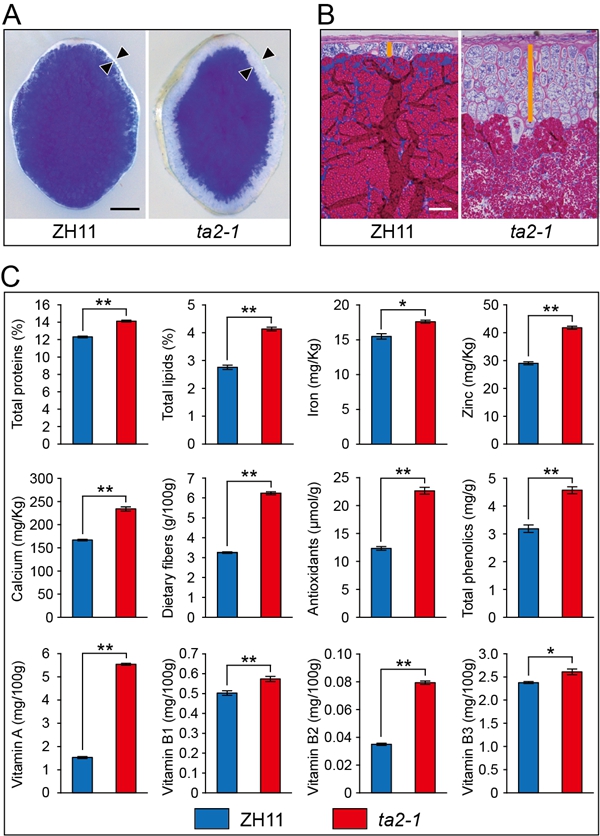The triploid cereal endosperm, consisting of an outer aleurone and an inner starchy endosperm, contributes to over 70% of the staple food consumed by humans. Although these two tissues have the same developmental origin, they differ in morphology, cell fate, and storage product accumulation. Starchy endosperm accumulates mainly starch, whereas the aleurone accumulates mainly storage proteins, lipids, vitamins, and minerals.
Recently, a team led by Prof. Chun-Ming Liu at the Institute of Botany, Chinese Academy of Sciences, in collaboration with Prof. Philip Larkin from CSIRO. Australia, screened approximately 36,000 ethyl methanesulfonate (EMS)-mutagenized rice seeds using a half-seed assay, and identified an elite thick aleurone 2 (ta2) line in which the aleurone has on average 4.8 ± 2.2 cell layers. Map-based cloning showed that a dominant negative mutation of a DNA demethylase, OsROS1, led to the thick aleurone phenotype of ta2. The contents of all measured nutritional factors including lipids, proteins, vitamins, minerals, and dietary fibers were increased for 30% to 300% in ta2 grains.
Furthermore, using an in-house TLLING platform, this team identified 5 addition new ta2 alleles with point mutations in OsROS1, providing important genetic materials for improving the nutritional value of rice. Currently, the team is trying to use gene editing technology to modulate the expression of DNA demethylase ROS1 in wheat, maize and other cereal crops to explore the possibilities to improve their nutritional value.
This study provides a theoretical basis for understanding epigenetic regulation of endosperm development and nutrient accumulation in cereal crops, and highlights the potential for manipulating OsROS1 activity to improve the nutritional value of rice and may have applications in other cereal crops as well.
This research entitled “Mutations in the DNA demethylase OsROS1 result in a thickened aleurone and improved nutritional value in rice grains” has been published in Proc. Natl. Acad. Sci. USA on October 1, 2018. Dr. Jinxin Liu and Dr. Xiaoba Wu contributed equally to this work, and Prof. Chun-Ming Liu is the corresponding author.
This work was supported by the Ministry of Science and Technology of China, the CAS-Innovation Project “Molecular Modules for Breeding Design”, and the CAS-CSIRO Bilateral Collaboration Project. 
Figure legend: (A) ta2-1, a dominant negative mutant of OsROS1, showed the thick aleurone phenotype. (B) ta2-1 exhibited the increased aleurone cell layer. (C) The total protein, lipid, iron,zinc, calcium, dietary fiber, antioxidant, phenolic, and vitamin A, B1, B2, B3 contents of ta2-1 grains were significantly higher compared with wild type.
ArticleLink: http://www.pnas.org/content/early/2018/09/26/1806304115?from=groupmessage&isappinstalled=0
Contact INFO:
Institute of Botany, Chinese Academy of Sciences,
20 Nanxincun, Xiangshan, Beijing 100093, China
Email: int_office@ibcas.ac.cn
The triploid cereal endosperm, consisting of an outer aleurone and an inner starchy endosperm, contributes to over 70% of the staple food consumed by humans. Although these two tissues have the same developmental origin, they differ in morphology, cell fate, and storage product accumulation. Starchy endosperm accumulates mainly starch, whereas the aleurone accumulates mainly storage proteins, lipids, vitamins, and minerals.
Recently, a team led by Prof. Chun-Ming Liu at the Institute of Botany, Chinese Academy of Sciences, in collaboration with Prof. Philip Larkin from CSIRO. Australia, screened approximately 36,000 ethyl methanesulfonate (EMS)-mutagenized rice seeds using a half-seed assay, and identified an elite thick aleurone 2 (ta2) line in which the aleurone has on average 4.8 ± 2.2 cell layers. Map-based cloning showed that a dominant negative mutation of a DNA demethylase, OsROS1, led to the thick aleurone phenotype of ta2. The contents of all measured nutritional factors including lipids, proteins, vitamins, minerals, and dietary fibers were increased for 30% to 300% in ta2 grains.
Furthermore, using an in-house TLLING platform, this team identified 5 addition new ta2 alleles with point mutations in OsROS1, providing important genetic materials for improving the nutritional value of rice. Currently, the team is trying to use gene editing technology to modulate the expression of DNA demethylase ROS1 in wheat, maize and other cereal crops to explore the possibilities to improve their nutritional value.
This study provides a theoretical basis for understanding epigenetic regulation of endosperm development and nutrient accumulation in cereal crops, and highlights the potential for manipulating OsROS1 activity to improve the nutritional value of rice and may have applications in other cereal crops as well.
This research entitled “Mutations in the DNA demethylase OsROS1 result in a thickened aleurone and improved nutritional value in rice grains” has been published in Proc. Natl. Acad. Sci. USA on October 1, 2018. Dr. Jinxin Liu and Dr. Xiaoba Wu contributed equally to this work, and Prof. Chun-Ming Liu is the corresponding author.

Figure legend: (A) ta2-1, a dominant negative mutant of OsROS1, showed the thick aleurone phenotype. (B) ta2-1 exhibited the increased aleurone cell layer. (C) The total protein, lipid, iron,zinc, calcium, dietary fiber, antioxidant, phenolic, and vitamin A, B1, B2, B3 contents of ta2-1 grains were significantly higher compared with wild type.
ArticleLink: http://www.pnas.org/content/early/2018/09/26/1806304115?from=groupmessage&isappinstalled=0
Contact INFO:
Institute of Botany, Chinese Academy of Sciences,
20 Nanxincun, Xiangshan, Beijing 100093, China
Email: int_office@ibcas.ac.cn
